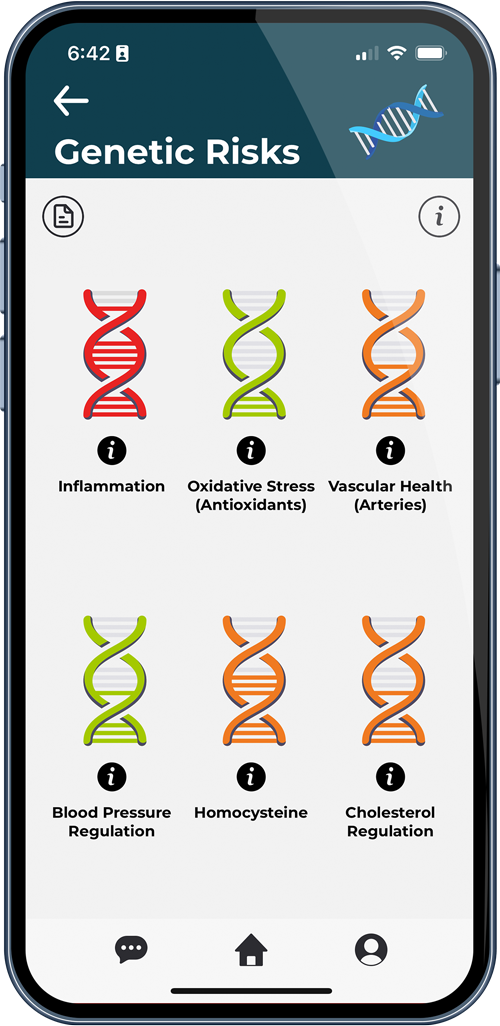Genetic Risks.
Your Genetic Risk Profile contains analysis of the genes that the CardiAction researchers consider most significant in determining cardiovascular health.
Knowing your genetic disposition allows us to better guide your lifestyle change.

Understanding Your Genetic Profile...
What are all these different groupings of information?
Grading Genetic Groupings
Your genetic profile highlights the genetic factors that most influence your cardiovascular health.
Each of the six groupings are categorised as high, medium or low.
HIGH | MEDIUM | LOW |
These gradings give an indication as to the potential influence each genetic grouping has on your health. However your health is also influenced by your current lifestyle, exercise, nutrition and supplement (LENS) choices.
For example, a genetic grouping categorised as high may have more impact on your cardiovascular health than a group that is categorised low.
Getting More Detail
There is a lot of detailed information associated with genetic analysis, as well as your individual genetic profile. To gain a better understanding of what sits behind your Genetic Profile, use the following information sources:
| Beneficial | One or both genes in the pair contributes to the optimal health functioning of the gene product. |
| Less Beneficial | One of the genes in the pair is contributing to a situation that impairs the healthy functioning of the gene product. |
| Least Beneficial | Both genes in the pair are contributing to a situation that impairs the healthy functioning of the gene product. |
Let's Consider Each Genetic Grouping...
Each genetic grouping plays a different role in effecting your health.
Inflammation
Inflammation is your body's natural response to repair damage and fight infection. But when the inflammatory process becomes inappropriate and chronic this is problematic, as instead of repairing damage, it can cause it.
Vascular Health
Having healthy arteries contributes to you having a healthy cardiovascular system. To achieve this all layers of the arterial wall must be functioning correctly. Structural changes to the layers of your arteries result in functional changes, such as thicker, less elastic arterial walls.
When this occurs there is an increased likelihood of a blood clot forming.
Blood Pressure Regulation
Blood pressure can be defined as: the pressure exerted by the blood upon the walls of the blood vessels. If arterial stiffness occurs (see Vascular Health above), this can contribute to a rise in your blood pressure. Your kidneys also play an important role in controlling your blood pressure, by maintaining a salt fluid balance.
Oxidative Stress
Oxygen is necessary for you to exist as it allows your body to function. Your body produces the energy that it needs by combining oxygen with food, known as the oxidation process. Free radicals are the by-products of this oxidation process.
Although the oxidation process is necessary for life, it causes problems when it becomes unbalanced and produces an excess of free radicals, causing oxidative stress, which can become harmful.
Homocysteine
A high level of homocysteine in the blood can make use more prone to damaging the endothelial lining of your arterial walls. This leads to inflammation in the blood vessels and can result in hardening of the arteries. High homocysteine is a known risk factor for coronary heart disease.
Cholesterol Regulation
Cholesterol is natural substance made in your body and is necessary for many functions. Having a high genetic vulnerability score for cholesterol regulation may indicate you have an increased chance of developing cardiovascular disease due to the likelihood of your body becoming susceptible to poor fat metabolism and oxidised-LDL.
